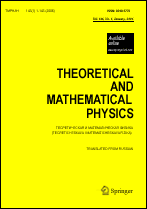|
This article is cited in 1 scientific paper (total in 1 paper)
Dark matter as a gravitational effect in the embedding theory approach
S. A. Paston
Faculty of Physics, Saint Petersburg State University,
St. Petersburg, Russia
Abstract:
We discuss a possibility to explain observations usually related to the existence of dark matter by passing from the general relativity (GR) theory to a modified theory of gravity, the embedding theory proposed by Regge and Teitelboim. In this approach, it is assumed that our space–time is a four-dimensional surface in a ten-dimensional flat ambient space. This clear geometric interpretation of a change of a variable in the GR action leading to a new theory distinguishes this approach from the known alternatives: mimetic gravity and other variants. After the passage to the modified theory of gravity, additional solutions that can be interpreted as GR solutions with additional fictitious matter appear besides the solutions corresponding to GR. In that theory, one can try to see dark matter, with no need to assume the existence of dark matter as a fundamental object; its role is played by the degrees of freedom of modified gravity. In the embedding theory, the number of degrees of freedom of fictitious matter is sufficiently large, and hence an explanation of all observations without complicating the theory any further can be attempted.
Keywords:
dark matter, embedding theory, modified theory of gravity, isometric.
Received: 25.01.2023
Revised: 25.01.2023
Citation:
S. A. Paston, “Dark matter as a gravitational effect in the embedding theory approach”, TMF, 216:3 (2023), 559–576; Theoret. and Math. Phys., 216:3 (2023), 1382–1395
Linking options:
https://www.mathnet.ru/eng/tmf10446https://doi.org/10.4213/tmf10446 https://www.mathnet.ru/eng/tmf/v216/i3/p559
|


| Statistics & downloads: |
| Abstract page: | 119 | | Full-text PDF : | 10 | | Russian version HTML: | 45 | | References: | 31 | | First page: | 13 |
|




 Contact us:
Contact us: Terms of Use
Terms of Use
 Registration to the website
Registration to the website Logotypes
Logotypes








 Citation in format
Citation in format 
